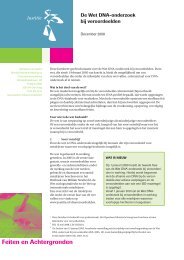INTERPOL HANDBOOK ON DNA DATA EXCHANGE AND PRACTICE
INTERPOL HANDBOOK ON DNA DATA EXCHANGE AND PRACTICE
INTERPOL HANDBOOK ON DNA DATA EXCHANGE AND PRACTICE
You also want an ePaper? Increase the reach of your titles
YUMPU automatically turns print PDFs into web optimized ePapers that Google loves.
APPENDIX 3what is forensic dna profiling?basic dna principles - the structure of dnaNuclear <strong>DNA</strong> molecules are made up of two strands that wrap around each otherin a helix to resemble a twisted ladder. The rungs of the ladder are made up of pairsof smaller molecules (monomers) called bases. There are four different bases presentin <strong>DNA</strong>: adenine (A), cytosine (C), guanine (G), and thymine (T). Each base only bindswith a specific complementary base - A with T and G with C. The binding of twocomplementary bases to form a ladder rung is called a base pair.Figure 7: Structure of nuclear <strong>DNA</strong>the human genomeThe human genome consists of approximately six billion base pairs along forty-six<strong>DNA</strong> molecules contained in twenty-three pairs of chromosomes in each cell nucleus.The order of bases along the <strong>DNA</strong> molecules is known as the <strong>DNA</strong> sequence.A gene is a particular area of a <strong>DNA</strong> molecule where the sequence of bases carriesinformation required to produce a particular protein from a particular sequence ofamino acids. Proteins provide the structural units for living organisms. Genes can varyin size, but average about 3,000 base pairs in length. Human <strong>DNA</strong> contains an estimated30,000 genes. Therefore, genetic or coding <strong>DNA</strong> makes up less than 5% of total human<strong>DNA</strong>. The remainder of the <strong>DNA</strong> is non-coding <strong>DNA</strong>.Some areas of non-coding <strong>DNA</strong> are consistent across all people, while other areasvary significantly between individuals. It is this variability that provides the basis fordistinguishing between individuals through <strong>DNA</strong> profiling.APPENDIX 3what is forensic dna profiling?PAGE 87







